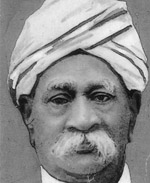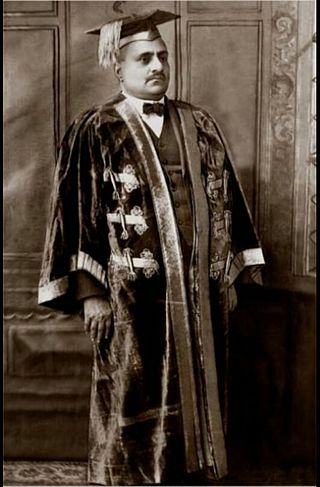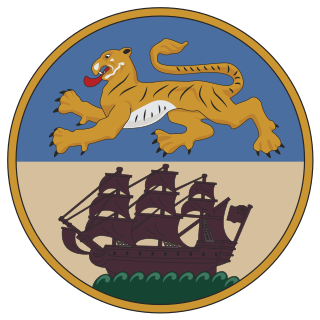Related Research Articles

The Bombay Presidency or Bombay Province, also called Bombay and Sind (1843–1936), was an administrative subdivision (province) of British India and later the Dominion of India, with its capital in the city that came up over the seven islands of Bombay. The first mainland territory was acquired in the Konkan region with the Treaty of Bassein. Poona was the summer capital.

Tamil Nadu Legislative Council was the upper house of the former bicameral legislature of the Indian state of Tamil Nadu. It began its existence as Madras Legislative Council, the first provincial legislature for Madras Presidency. It was initially created as an advisory body in 1861, by the British colonial government. It was established by the Indian Councils Act 1861, enacted in the British parliament in the aftermath of the Indian Rebellion of 1857. Its role and strength were later expanded by the second Council Act of 1892. Limited election was introduced in 1909. The Council became a unicameral legislative body in 1921 and eventually the upper chamber of a bicameral legislature in 1937. After India became independent in 1947, it continued to be the upper chamber of the legislature of Madras State, one of the successor states to the Madras Presidency. It was renamed as the Tamil Nadu Legislative Council when the state was renamed as Tamil Nadu in 1969. The Council was abolished by the M. G. Ramachandran administration on 1 November 1986. In 1989, 1996 and 2010, the DMK regime headed by M. Karunanidhi tried to revive the Council. The former AIADMK regime (2016-2021) expressed its intention not to revive the council and passed a resolution in the Tamil Nadu Legislative Assembly in this regard.

The Imperial Legislative Council (ILC) was the legislature of British India from 1861 to 1947. It was established under the Charter Act of 1853 by providing for the addition of 6 additional members to the Governor General Council for legislative purposes. Thus, the act separated the legislative and executive functions of the council and it was this body within the Governor General's Council which came to known as the Indian/Central Legislative Council. In 1861 it was renamed as Imperial Legislative Council and the strength was increased.

The Council of State was the upper house of the legislature for British India created by the Government of India Act 1919 from the old Imperial Legislative Council, implementing the Montagu–Chelmsford Reforms. The Central Legislative Assembly was the lower house.

The first legislative council election to Madras Presidency after the establishment of dyarchical system of government by the Government of India Act 1919, was held in November 1920. Indian National Congress boycotted the election due to its participation in the Non-cooperation movement. The election occurred during the early stages of non-Brahmin movement and the major issue of the election was anti-Brahminism. Justice party won the election with no significant opposition and A. Subbarayalu Reddiar became the inaugural First Minister of the presidency.

The third legislative council election to Madras Presidency after the establishment of dyarchical system of government by the Government of India Act, 1919, was held in November 1926. Justice party lost the election to Swaraj Party. However, as the Swaraja Party refused to form the Government, the Governor of Madras set up an independent government under the leadership of P. Subbarayan and with the support of nominated members.

In the fifth legislative council election to Madras Presidency after the establishment of dyarchical system of government by the Government of India Act, 1919 the ruling Justice party lost the election and the opposition Swaraj Party emerged as the single largest party. However, it refused to form the government, due to its opposition to dyarchy. The incumbent First Minister, Raja of Bobbili retained power and formed a minority government.
Diarchy was established in Madras Presidency based on the recommendations of the Montague-Chelmsford report. Five elections were held during the period diarchy was in effect and Justice Party occupied power most of the time. It ended with the election in 1937 when the Government of India Act 1935 came into effect.

General elections were held in British India in 1934. The Indian National Congress emerged as the largest party in the Central Legislative Assembly.

General elections were held in British India in 1920 to elect members to the Imperial Legislative Council and the Provincial Councils. They were the first elections in the country's modern history.
General elections were held in British India in November 1923 for both the Central Legislative Assembly and Provincial Assemblies. The Central Legislative Assembly had 145 seats, of which 105 were elected by the public.

General elections were held in British India between 28 October and late November 1926 to elect members of the Imperial Legislative Council and the Provincial Legislative Councils.
General elections were held in British India in September 1930. They were boycotted by the Indian National Congress and marked by public apathy. The newly elected Central Legislative Assembly met for the first time on 14 January 1931.
The elections to the two houses of legislatures of the Bombay Presidency were held in 1937, as part of the nationwide provincial elections in British India. The Indian National Congress was the single largest party by winning 86 of 175 seats in the Legislative Assembly and 13 of 60 seats in the Legislative Council.
Diarchy was established in Bombay Presidency based on the recommendations of the Montague-Chelmsford report. It ended with the election in 1937 when the Government of India Act 1935 came into effect.

The Legislatures of British India included legislative bodies in the presidencies and provinces of British India, the Imperial Legislative Council, the Chamber of Princes and the Central Legislative Assembly. The legislatures were created under Acts of Parliament of the United Kingdom. Initially serving as small advisory councils, the legislatures evolved into partially elected bodies, but were never elected through suffrage. Provincial legislatures saw boycotts during the period of dyarchy between 1919 and 1935. After reforms and elections in 1937, the largest parties in provincial legislatures formed governments headed by a prime minister. A few British Indian subjects were elected to the Parliament of the United Kingdom, which had superior powers than colonial legislatures. British Indian legislatures did not include Burma's legislative assembly after 1937, the State Council of Ceylon nor the legislative bodies of princely states.

The Bengal Legislative Council was the legislative council of Bengal Presidency . It was the legislature of the Bengal Presidency during the late 19th and early 20th centuries. After reforms were adopted in 1937, it served as the upper house of the Bengali legislature until the partition of India.
Hashmatrai Khubchand Chainani was the Chief Justice of the Bombay High Court.
References
- ↑ "75 years and at it". Afternoon Despatch & Courier. 25 July 2011. Retrieved 23 August 2013.
- ↑ Bhargava, Rajeev; Reifeld, Helmut (27 May 2005). Civil Society, Public Sphere and Citizenship: Dialogues and Perceptions. SAGE Publications. p. 116. ISBN 9780761998327.
- ↑ Cashman, Richard (1975). The Myth of the Lokamanya: Tilak and Mass Politics in Maharashtra . University of California Press. p. 64. ISBN 9780520024076.
- ↑ Dictionary of Indian Biography. Haskell House Publishers Ltd. 1971.
- ↑ Legislative Council, Bombay (India : State). Legislature (1880). Proceedings of the Council of the Governor of Bombay Assembled for the Purpose of Making Laws.
- ↑ "PUBLIC LIFE AND VOLUNTARY SOCIAL SERVICE ORGANISATIONS". Archived from the original on 6 June 2013.
- ↑ Proceedings Council of the Governor of Bombay Assembled for the purpose of making laws and regulations. Authority of His Excellency the Governor. 1897.
- ↑ India Office, Great Britain (1905). The India List and India Office List. p. 89.
- 1 2 Basu, Aparna (2001). G.L. Mehta, a Many Splendoured Man. Concept Publishing Company. p. 53. ISBN 9788170228912.
- ↑ Mithra, H.N. (2009). The Govt of India ACT 1919 Rules Thereunder and Govt Reports 1920. BiblioBazaar. pp. 186–199. ISBN 978-1-113-74177-6.